Recovery Basics
Anyone who is pursuing any sort of fitness endeavors should have a recovery plan! It will help you prevent injuries, get your body ready to go again for your next skating lesson or other activity, and it helps you maintain mobilization and flexibility in your body so you should have less general aches and pains.
Here is some general info about recovery methods:
Foam Roll!
Foam rolling is important to do before and/or after a workout. It promotes blood circulation to help your muscles recover faster or to become pliable for a workout. It also releases tension in your fascia (the stuff that binds together your muscle fibers) which stretching cannot always do. Sometimes athletes are actually more tight in their fascia than in their muscles.
Types of Foam Rollers
Foam rolling will make you sore at first. It is a good idea for beginners in foam rolling to start with a soft foam roller and then work their way up to harder foam roller with massage points/soft spikes on it. The soft spikes get into the fascia even more. If you need more than that, there are foam rollers with a massage setting you can buy.
You can get a foam roller anywhere~ Amazon, Target, any fitness store. You only need to get one that is about twelve inches long.
Sometimes it’s difficult to travel with a foam roller. Rolling sticks, collapsible foam rollers, and travel-size foam rollers are all good options.
Beginning to Foam Roll
Foam rolling will make you sore at first. It takes about two weeks of foam rolling everyday to get your muscles used to foam rolling. It probably will hurt and won’t feel good at first, but that means you need it. Foam roll especially the spots that hurt.
Never foam roll over a joint! (i.e. your knees and elbows~ loose joints are not good!)
A good full-body foam roll targets each muscle group. Here is a video that does a good job showing you all of this, and you can foam roll and follow along until you have it memorized.
Other Types of Rolling
Sometimes there are crunchy spots on your body that a foam roller can’t get into, particularly around your ankle bone, achilles tendon and the back of your neck. Use a spiky massage ball to get into those nooks and crannies.
Skaters often times have tight feet. The best thing to do for tight feet is to roll your feet out with a tennis ball, golf ball or spiky massage ball. The smaller the ball the more painful, but effective, it is! You will simply stand and roll the ball around under your feet for ten minutes twice per day.
Stretching
Athletes should do about 20-30 min of stretching per day to help prevent injuries. You should stretch out all of your major muscle groups by holding each stretch for 20-60 sec. For long stretches like this, always do it after you skate or are athletic. Do not do long stretches before you skate. The easiest way to incorporate stretching into your day is while you’re reading a book or watching television.
There are TONS of different stretches out there. It is good to vary what you do every couple of weeks or so, but here is a comprehensive chart of lots of good basic stretches that everyone should do.
Other Recovery Methods
Getting lots of sleep! Athletes under 18 years old need about 9-11 hours of sleep each night.
Drink lots of water after a workout~ being dehydrated makes the muscles recover slower.
Eat a serving of protein within 30 minutes after an intense workout.
Epsom salt baths~ you can take one as frequently as once per day or just a couple of times a week.
Massagers/Massage Guns- be gentle using these at first.
Sports Massage~ if the athlete is having persistent pain/tightness and feel like they need more help in their recovery work.
Hot and Cold Therapy~ you can do ice baths, cold plunges, saunas, cryotherapy, etc. Make sure to consult with a medical professional before deciding if these are needed/right for your athlete.
Cupping, acupuncture, gua sha/scraping massages~ these are more extreme/intense types of recovery that not every athlete needs, but they are available. Discuss with your medical professional if this is right for your athlete.
And of course, rest. Make sure skaters/athletes have time to rest in between workouts, and it’s generally good to have about one day per week where the athlete isn’t doing any workouts/intense practices.

